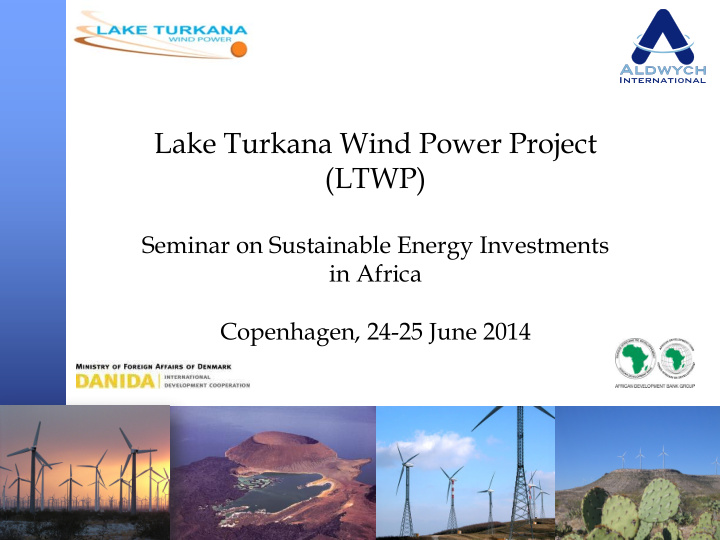



Lake Turkana Wind Power Project (LTWP) Seminar on Sustainable Energy Investments in Africa Copenhagen, 24-25 June 2014
LTWP Project Summary • 310MW wind farm, located in northern Kenya, near Lake Turkana • When completed, will be the largest wind farm in Africa • Consists of 365 Vestas V52 (850 kV) wind turbines, overhead electric grid connection system and high-voltage sub-station • Includes upgrading of 204km of existing road and construction of new access road and village • Double circuit 400kV, 428 km transmission line (financed by Spanish and Kenyan government funds) to connect to national grid • In development since 2006 • 20-year energy-only PPA with KPLC, Government letter of support backing KPLC’s obligations • Total project cost €622 million: the largest single private investment in Kenya to date • Mandated lead debt arrangers: African Development Bank, Nedbank and Standard Bank • PRG: African Development Bank; breach of contract insurance: ATI • Aldwych will oversee construction and will operate the plant • Financial Close targeted Q3 2014 2
Project Location LTWP Location The proposed project is a 310 MW Wind Park to be constructed approximately 450km North of Nairobi The wind farm site, covering 40,000 acres (162km 2 ), is located in Loiyangalani District, Marsabit West County approximately 50km north of South Horr Township. 3 3
Sponsor Group and Equity Commitments Joint Development Parties Equity • KP&P BV Africa (original sponsors) • €31 million • Aldwych International Limited • €38 million • Wind Power A.S. (Vestas) • €16 million • Norwegian Investment Fund for • €16 million Developing Countries (Norfund) • Danish Investment Fund for • €7.5 million Developing Countries (IFU) • Finnish Fund for Industrial • €16 million Cooperation Ltd (Finnfund) • Sandpiper • 0.5 million 4
Wind and tariff • The site lies between 450m at the shore of Lake Turkana and 2,300m above sea level at the top of Mt. Kulal. Strong predictable wind streams are generated between Lake Turkana (with relatively constant temperature) and the desert hinterland (with steep temperature fluctuations) • Wind streams pass through the valley which effectively acts as a funnel (the Turkana Corridor low level jet stream). The Turkana wind blows in a south-east direction all year round • Data collected and analysed since 2007 indicate that site has some of the best wind resources in Africa, with consistent, unidirectional, daily wind speeds averaging at least 11 meters/second • This creates a capacity factor of 62% for the wind farm, which is world-class and a major factor in providing a competitive power tariff, approximately 60% cheaper than thermal power plants and below the FIT for wind in Kenya 5
Environmental Credentials • The Project Environmental Impact Assessment Licence was granted on 24 July 2009 • The Project has been developed in compliance with all relevant local and international legislation and standards, including the IFC Performance Standards and Equator Principles • The Project achieved CDM accreditation with the UNFCCC in February 2011 at Gold Standard rating • It is expected that average annual emission reductions of 728,483 t CO2 per year will be generated during the first crediting period • Income from the carbon credits will be shared with the government and invested in the community (next slide) • Annual environmental audits will be carried out for the entire wind farm during the 20 years of operations 6
Community Development and Macro-Economic Impact • Marsabit West County is among the poorest counties in Kenya; Loiyangalani is one of the poorest districts in Marsabit • A CSR programme is being finalised based on extensive input from the nomadic and pastoral communities; LTWP will use a combination of revenue from carbon credits and profit to form and fund a trust, which will ensure a well targeted plan over the 20 years of the investment • Will replace need for Kenya to spend approximately Ksh13.7 billion (€120 million) per year on importing fuel • The LTWP tax contribution to Kenya will be approximately Ksh2.7 billion (€22.7 million) per year and Ksh58.6 billion (€450 million) over the life of the investment • Jobs: During the 32-month construction period, up to approximately 2,500 jobs will be created, followed by over 200 full time jobs throughout the period of operations 7
Sources of Funds Senior Sources Tranche A AfDB €115m Tranche ‘B’ ECA Facility Covered € 20m Tranche ‘B’ ECA Facility Uncovered €100m EIB Senior Loan ‘A’ €50m EIB Senior Loan ‘B’ €50m Tranche ‘C’ DFI Facilities FMO €35, Proparco €20, ICCF €30m PTA €101m Bank €10 & Tridos €6m Senior € 435 Mezzanine Finance Subordinated debt DEG €20,EADB €5m, PTA €10m & AfDB 2m €37m ITF preference share €25m Mezzanine €62m Equity Aldwych €38 KP&P €31 IFU €7.5m Norfund €16m Finnfund €16m Vestas €16m Sandpiper €0.5 Equity €125m Total €622m 8
Uses of Funds Uses Vestas contract €318m Siemens contract €44m Other technical contracts €68m IDC plus contingency €70m Development costs and fees €59m Construction costs €12m Financing Costs €15m DSRA €36m Total €622m 9
Current Status • On 24 March 2014 LTWP signed the financing documents with African Development Bank (AfDB) as the lead arranger, European Investment Bank (EIB), Standard Bank of South Africa, Nedbank, FMO, Proparco, East African Development Bank, PTA Bank, EKF, Triodos and DEG. The Overseas Private Investment Corporation (OPIC) has recently received approval to join the lender group • The major outstanding condition precedent is the issuance by Ketraco of the delayed Notice to Proceed (NTP) to Isolux, for construction to start on the transmission line • Following NTP, the Project will proceed to equity closing and then to full Financial Close and into construction once lender security has been perfected 10
Recommend
More recommend